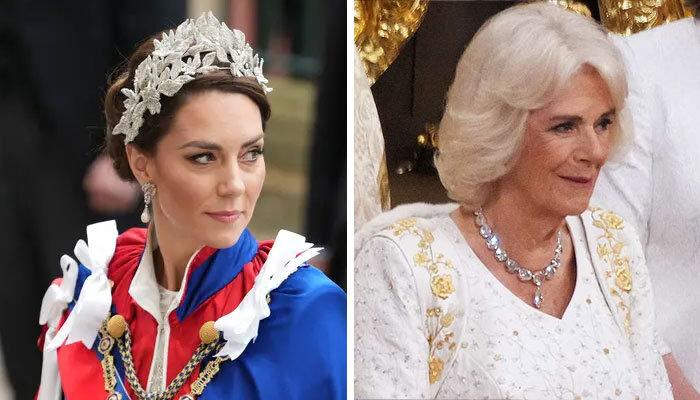In a stunning and unexpected development that has sent shockwaves through the United Kingdom and beyond, Catherine, Princess of Wales, has been elevated to a new royal role—while Queen Camilla has reportedly been stripped of her title in what insiders are calling “the most dramatic reshuffle in recent royal history.”
The Palace has not officially confirmed the full details, but multiple sources have indicated that this decision was made behind closed doors in recent weeks, with the King’s health and public sentiment playing a major role in the shift. And while the announcement was handled with royal tact, the implications are seismic.

A Queen No More?
Camilla, once seen as the stabilizing partner to King Charles III, has quietly stepped back from public duties over the last few months. Official statements had attributed this to “health concerns” and “fatigue,” but royal watchers suspected more was unfolding behind the palace gates.
Now, it appears those suspicions were justified.
Sources close to the Palace reveal that King Charles, influenced by public opinion and internal counsel, has revoked Camilla’s Queen Consort title, reassigning her to a lesser ceremonial role. Though still married to the King, her royal influence has effectively diminished—and it happened without fanfare, without ceremony, and without her even addressing the public.
One royal insider noted:
“This wasn’t just about the crown. It was about legacy. And the King knows where the public heart truly lies.”
The Rise of Catherine
As Camilla steps back, Princess Catherine steps forward—not as a quiet consort, but as a future queen-in-waiting already stepping into that role. Over the past year, the Princess of Wales has gracefully navigated personal challenges, including her own health battles, with courage and dignity. She has emerged not only as a symbol of stability but also as a beacon of modern royalty.
This week, she was reportedly granted expanded constitutional responsibilities, including a private audience with the Prime Minister and increased involvement in state functions. Rumors are circulating that she may soon take on the role of Queen-in-Acting during periods of the King’s absence or health-related retreats.
And the people? They’re fully behind her.
Public Reaction: “Finally, the Queen We’ve Been Waiting For”
Social media erupted as news of the royal shakeup began to spread.
“Kate’s been the heart of the monarchy for years. Now she’s finally its face,” wrote one user on X (formerly Twitter).
“Camilla never had the nation’s full acceptance. Kate was born for this,” said another.
“It feels like the monarchy is healing,” read a post that has since gone viral.
Even long-time critics of the royal family are praising the shift as a move toward transparency, grace, and generational transition.

What This Means for the Royal Future
The implications of this shift reach far beyond titles.
By redefining royal roles, the Crown is signaling a new era—one that places trust in youth, compassion, and public unity. Kate has always maintained a deep connection to the people, and now, she is being entrusted to help lead the monarchy through a time of change and renewal.
Palace aides say she will soon spearhead a new mental health initiative across the Commonwealth and will be the central figure during the upcoming Remembrance Day ceremonies—positions traditionally reserved for reigning queens or consorts.
A Monarchy Reborn?
Whether Queen Camilla’s removal was a graceful retreat or a strategic correction, one thing is certain: Catherine’s ascension has reignited public interest and support for the royal family. Her presence brings not just elegance, but also authenticity—something the monarchy desperately needs in a modern world.
As one royal correspondent put it:
“This wasn’t just a change in titles. This was the monarchy listening to its people—and answering with Kate Middleton.”
And so, a new chapter begins. Quietly written in duty, sealed in dignity, and carried forward by a woman the world already calls queen—whether crowned or not.
